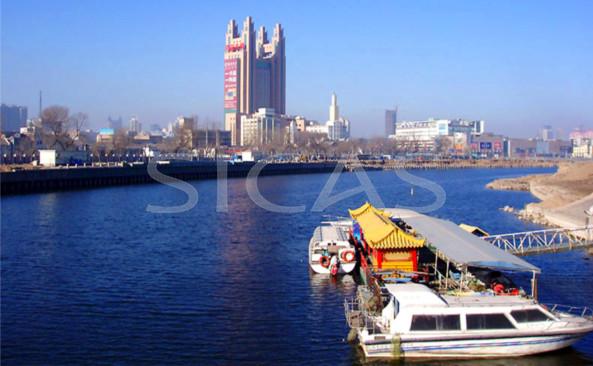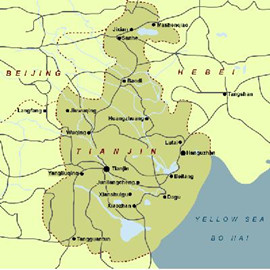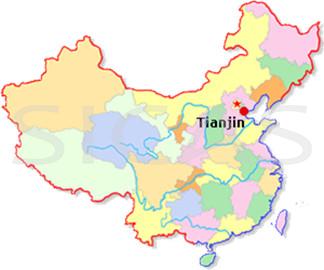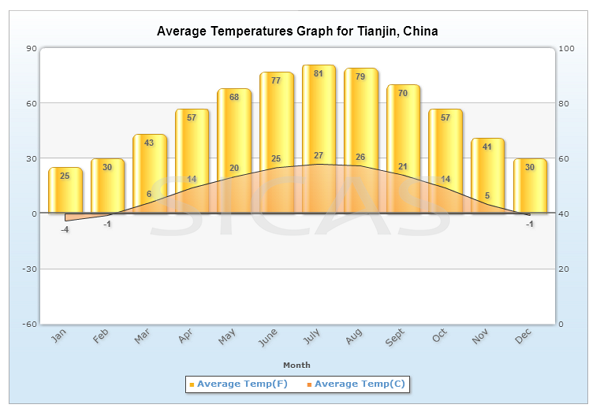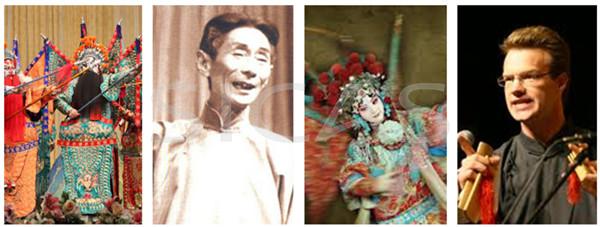 |
Tianjin is a metropolis in nortof the five national central cities of the People's Republic of China (PRC). It is governed as one of the four direct-controlled municipalities of the PRC, and is thus under direct administration of the central government. Tianjin borders Hebei Province and Beijing Municipality, bounded to the east by the Bohai Gulf portion of the Yellow Sea. Part of the Bohai Economic Rim, it is the largest coastal city in northern China.
In terms of urban population, Tianjin is the fourth largest in China, after Shanghai, Beijing, and Guangzhou. Tianjin is a dual-core city, with its main urban area (including the old city) located along the Hai River, which connects to the Yellow and Yangtze Rivers via the Grand Canal; and Binhai, a New Area urban core located east of the old city, on the coast of Bohai Sea. As of the end of 2010, around 285 Fortune 500 companies have set up base in Binhai, which is a new growth pole in China and is a hub of advanced industry and financial activity. Since the mid-19th century, Tianjin has been a major seaport and gateway to the nation's capital.
Tianjin is located along the west coast of the Bohai Gulf, looking out to the provinces Shandong and Liaoning across those waters, bordered by Beijing 120 kilometres (75 mi) to the northwest, and except for the east, is surrounded on all sides by Hebei. With a latitude ranging from 38° 34' to 40° 15' N, and longitude ranging from 116° 43' to 118° 04' E, the total area is 11,860.63 km2 (4,579.41 sq mi). There is 153 km (95 mi) of coastline and 1,137.48 km (706.80 mi) of land border. It lies at the northern end of the Grand Canal of China, which connects with the Yellow River and Yangtze River. The municipality is generally flat, and swampy near the coast, but hilly in the far north, where the Yan Mountains intrude into northern Tianjin. The highest point in the municipality is Jiuding Peak in Ji County on the northern border with Hebei, at an altitude of 1,078.5 m (3,538 ft).
Climate Tianjin features a four season, monsoon-influenced climate, typical of East Asia, with cold, windy, very dry winters reflecting the influence of the vast Siberian anticyclone, and hot, humid summers, due to the monsoon. Spring in the city is dry and windy, occasionally seeing sandstorms blowing in from the Gobi Desert, capable of lasting for several days. The monthly 24-hour average temperature ranges from −3.5 °C (25.7 °F) in January to 26.6 °C (79.9 °F) in July, with an annual mean of 12.66 °C(54.8 °F). Sunshine, at 2,522 hours annually, is quite generous during most of the year. With the low annual total precipitation of 540 millimetres (21.3 in), and nearly three-fifths of it occurring in July and August alone, the city lies within the humid continental zone, with parts of the municipality being semi-arid (Köppen Dwa/BSk, respectively).
Extreme temperatures have ranged from −22.9 °C (−9 °F) to 40.5 °C (105 °F). Culture People from Tianjin speak the Tianjin dialect of Mandarin, from which it is derived. Despite its proximity to Beijing, the Tianjin dialect sounds quite different from the Beijing dialect, which provides the basis forPutonghua, the official spoken language of the People's Republic of China.
Tianjin is a respected home base of Beijing opera, one of the most prestigious forms of Chinese opera.
Chinese Opera and Xiangsheng
Yangliuqing (Green Willows), a town about 15 km (9.3 mi) west of Tianjin's urban area and the seat of Xiqing District, is famous for its popular Chinese New Year-themed, traditional-style, colourful wash paintings. Tianjin is also famous for Zhang's clay figurines which are a type of colourful figurine depicting a variety of vivid characters, and Tianjin's Wei's kites, which can be folded to a fraction of their full sizes, are noted for portability. |








